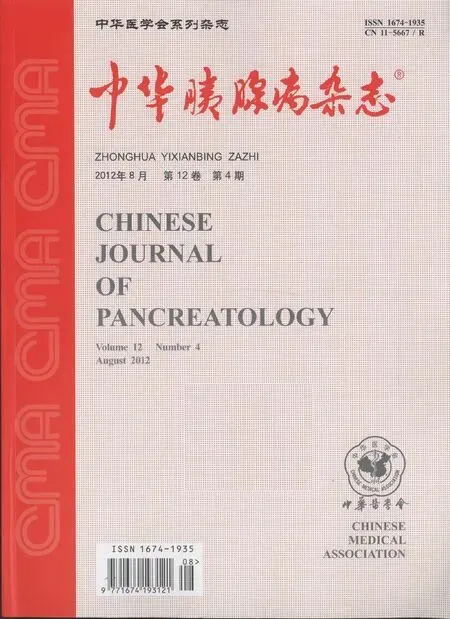BISAP评分对急性胰腺炎严重程度及预后评估的临床价值
陈丽芬 陆国民 周群燕 占强
·论著·
BISAP评分对急性胰腺炎严重程度及预后评估的临床价值
陈丽芬 陆国民 周群燕 占强
目的通过与传统的急性胰腺炎(AP)病情评分系统比较,了解急性胰腺炎严重程度床边指数(BISAP)评分对AP严重程度及预后评估的临床价值。方法回顾性分析2005年1月至2010年12月间收治的497例AP患者资料,分别进行BISAP、APACHEⅡ、Ranson及Balthazar CT(CTSI)评分,评估病情严重程度。应用受试者工作曲线下面积(AUC)比较BISAP评分与其他各评分系统对AP严重程度及胰腺坏死、器官功能衰竭、患者病死发生的预测能力。结果497例患者中重症急性胰腺炎(SAP)101例,轻症急性胰腺炎(MAP)396例,MAP组和SAP组患者的年龄、性别、病因分布差异无统计学意义。497例患者的BISAP评分、APACHEⅡ评分、Ranson评分的平均分值分别为(1.08±1.01)、(5.79±4.00)、(1.69±1.59)分,两两相关(r值分别为0.612、0.568、0.577,P值均<0.001)。此外,SAP患者的BISAP评分、APACHEⅡ评分、Ranson评分的分值均显著大于MAP患者(P值均<0.01)。BISAP评分预测SAP的AUC值为0.762(95%CI0.722~0.799),阳性截止(cutoff)值为2分,敏感性、特异性、阳性预测值、阴性预测值分别为63.4%、83.1%、48.1%、89.4%;预测胰腺坏死的AUC值为0.711(95%CI0.612~0.797),cutoff值为2分,敏感性、特异性、阳性预测值、阴性预测值分别为84.6%、46.7%、35.5%、89.7%;预测器官衰竭的AUC值为0.777(95%CI0.683~0.854),cutoff值为2分,敏感性、特异性、阳性预测值、阴性预测值分别为93.1%、51.4%、43.5%、94.9%;预测患者病死的AUC值为0.808(95%CI0.718~0.880),cutoff值为3分,敏感性、特异性、阳性预测值、阴性预测值分别为83.3%、67.4%、25.6%、96.8%。BISAP评分与其他评分系统预测SAP各预后指标的差异均无统计学意义。结论BISAP评分对AP严重程度及预后的评估价值与其他传统的评分系统相同,但其只有5项指标,且均可在入院24 h内采集,可以早期、简便地预测SAP,值得在临床推广应用。
胰腺炎; 疾病严重程度指数; BISAP评分; 预后
临床上大多数急性胰腺炎(AP)患者的病程呈自限性,20%~30%患者可发展为重症急性胰腺炎(SAP)。AP总体病死率为5%~10%[1]。如果在AP早期能对患者进行准确病情评估,将有助于对患者进行个体化治疗,从而达到良好的治疗效果并节省医疗资源。目前常用的评价AP严重程度的评分系统包括Ranson评分、APACHEⅡ评分、CTSI评分,但均各有利弊[2-6]。近年来,国外学者提出了一个新的评分系统[7],即为急性胰腺炎严重程度床边指数(bedside index for severity in acute pancreatitis, BISAP)。本研究应用BISAP系统对我院AP患者进行评分,并与传统的评分系统进行比较,探讨BISAP评分预测SAP的临床应用价值。
资料和方法
一、临床资料
收集2005至2010年期间我院收治的资料完整的AP患者,排除发病3 d后入院或在其他医院治疗超过3 d转入我院的AP患者。诊断均符合中华医学会消化病学分会胰腺病学组制定的标准[1],SAP诊断参照亚特兰大标准(1992年)[8]。患者入院后根据病情采用禁食、胃肠减压、抑酸、抑制胰酶分泌、改善微循环、酌情抗感染及补液等治疗,必要时采用肠内营养对症治疗,有并发症者采取相应的处理。
二、数据评分及分析
根据患者24 h内的病例资料进行APACHEⅡ评分、BISAP评分,根据患者48 h内的病例资料进行Ranson评分,对症状出现后3 d内行增强CT的患者行CTSI评分。比较BISAP评分、APACHEⅡ评分和Ranson评分预测SAP的价值,同时比较BISAP评分与Ranson评分、APACHE Ⅱ评分预测SAP患者胰腺坏死、器官衰竭和病死的价值,比较BISAP评分与CTSI评分预测SAP患者器官衰竭和病死的价值。
三、统计学处理

结 果
一、一般情况分析
本研究共收集患者497例,其中男性275例(55.3%),女性222例(44.7%),平均年龄(54±17)岁。病因:胆源性328例(66.0%),酒精性34例(6.8%),高脂血症性50例(10.1%),特发性80例(16.1%),其他原因(手术、外伤、肿瘤)5例(1.0%)。SAP患者101例(20.3%),轻症急性胰腺炎(MAP)患者396例(79.7%)。SAP患者中,发生器官衰竭29例(28.7%),出现胰腺坏死26例(25.7%),病死13例(12.9%)。两组患者性别、年龄、病因具有可比性。
二、各评分系统分值分析
497例患者中,BISAP、APACHEⅡ、Ranson评分平均分值分别为(1.08±1.01)、(5.79±4.00)、(1.69±1.59)分,两两比较的相关系数分别为0.612、0.568、0.577,P值均<0.001。此外,SAP组3种系统的评分值均显著大于MAP组(表1)。

表1 MAP组和SAP组患者各评分系统的分值
三、各评分系统预测SAP的价值
BISAP评分、APACHEⅡ评分、Ranson评分预测SAP的AUC值分别为0.762(95%CI0.722~0.799)、0.755(95%CI0.714~0.792)、0.801(95%CI0.763~0.835)。各评分系统间的差异无统计学意义(图1a)。
根据约登指数计算出BISAP评分、APACHEⅡ评分、Ranson评分预测SAP的最佳cutoff值分别为2、8、3分,BISAP评分预测SAP的敏感性、特异性、阳性预测值、阴性预测值分别为63.4%、83.1%、48.1%、89.4%;APACHEⅡ评分为59.4%、82.3%、46.2%、88.8%;Ronson评分为64.4%、86.4%、54.6%、90.5%,各组间差异无统计学意义。
四、各评分系统预测SAP预后的价值
1.预测SAP胰腺坏死:BISAP评分、APACHEⅡ评分、Ranson评分预测胰腺坏死的AUC值分别为0.711(95%CI0.612~0.797)、0.703(95%CI0.603~0.789)、0.704(95%CI0.605~0.791),各评分系统间差异无统计学意义(图1b)。
3个评分的最佳cutoff值分别为2、13、5分。BISAP评分预测SAP的敏感性、特异性、阳性预测值、阴性预测值分别为84.6%、46.7%、35.5%、89.7%;APACHEⅡ评分为53.9%、84.0%、53.8%、84.0%;Ronson评分为50.0%、84.0%、52.0%、82.9%,各评分系统间差异无统计学意义。
2.预测SAP器官衰竭:BISAP评分、APACHEⅡ评分、Ranson评分、CTSI评分预测器官衰竭发生的AUC值分别为0.777(95%CI0.683~0.854)、0.811(95%CI0.721~0.882)、0.750(95%CI0.653~0.830)、0.675(95%CI0.574~0.765)。BISAP评分与其他3个评分系统的比较差异无统计学意义,但APACHEⅡ评分的AUC明显大于CTSI评分(Z=2.174,P=0.030,图1c)。
4个评分的最佳cutoff值分别为2、13、5、6分。BISAP评分预测SAP的敏感性、特异性、阳性预测值、阴性预测值分别为93.1%、51.4%、43.5%、94.9%;APACHEⅡ评分为62.1%、88.9%、69.2%、81.6%;Ronson评分为51.7%、86.1%、60.0%、81.6%;CTSI评分为48.3%、95.8%、82.4%、82.1%,各评分系统间差异无统计学意义。
3.预测SAP患者的病死:BISAP评分、APACHEⅡ评分、Ranson评分、CTSI评分预测患者病死发生的AUC值分别为0.808(95%CI 0.718~0.880)、0.796(95%CI0.705~0.870)、0.852(95%CI0.768~0.915)、0.868(95%CI0.787~0.927),各评分系统间差异无统计学意义(图1d)。
4个评分的最佳cutoff值分别为3、13、5、6分。BISAP评分预测SAP的敏感性、特异性、阳性预测值、阴性预测值分别为83.3%、67.4%、25.6%、96.8%;APACHEⅡ评分为75.0%、80.9%、34.6%、96.0%;Ronson评分为83.3%、83.2%、40.0%、97.4%;CTSI评分为83.3%、92.1%、58.8%、97.6%,各评分系统间差异无统计学意义。

图1BISAP评分、APACHEⅡ评分、Ranson评分预测SAP(a)、胰腺坏死(b)的ROC以及3种评分加上CTSI评分预测SAP病死发生(c)、器官衰竭(d)的ROC
讨 论
亚特兰大标准综合评价了AP患者在疾病发生发展过程中的器官特异性(局部)及病理生理学(系统)的改变[9],但它不能满足早期病情评估的需求。由于既往研究[9-10]将亚特兰大标准作为诊断SAP的标准,故本研究采用亚特兰大标准作为诊断SAP的依据。
Ranson评分和APACHEⅡ评分在临床上被普遍应用于AP病情的评估。目前公认, Ranson评分≥3分或APACHEⅡ评分≥8分时提示SAP,这和本研究通过ROC曲线分析所得的Ranson评分和APACHEⅡ评分诊断SAP的最佳cutoff值一致。2007年Forsmark等[11]报道,Ranson评分预测SAP的敏感性为75%,特异性为77%,阳性预测值为49%,阴性预测值为91%,入院时APACHEⅡ评分预测SAP的敏感性为65%,特异性为76%,阳性预测值为43%,阴性预测值为89%。本组病例较之敏感性略低而特异性略高,这可能和病例样本的差异有关。
BISAP评分体系是2008年Wu等[7]利用分类回归数算法对2000年至2001年的212家医院的17 992例AP患者进行研究,筛选出5个最能预测SAP的指标,应用这5项指标对177家医院2004年至2005年间的18 256例AP患者进行评估,并与APACHEⅡ评分进行对比验证后提出的。Papachristou等[12]报告,BISAP评分≥3分时预测SAP敏感性为37.5%,特异性为92.4%,阳性预测值为57.7%,阴性预测值为84.3%。本研究中通过ROC曲线分析得出BISAP评分预测SAP的最佳cutoff值为2分,当BISAP评分≥2分时,其诊断SAP的敏感性为61.4%,特异性为83.1%,阳性预测值为48.1%,阴性预测值为89.4%,相比之下敏感性高而特异性低。若采用BISAP评分≥3分进行SAP诊断时,其敏感性为38.6%,特异性为93.2%,阳性预测值为59.1%,阴性预测值为85.6%,则与Papachristou 等的研究结果相似。
本研究结果显示,与APACHEⅡ、Ranson、CTSI评分系统比较,BISAP评分在预测SAP的敏感性、特异性,预测胰腺坏死、器官衰竭发生、患者病死等方面均无明显差异。但BISAP评分作为一个新的评分系统,其参数数据只包括体征、实验室检查和影像学资料等5项指标,易于获得,计算简单,且均可在入院24 h内采集,可以早期、简便地预测SAP[13],值得在临床推广应用。
[1] 中华医学会消化病学分会胰腺疾病学组.中国急性胰腺炎诊治指南(草案).中华胰腺病杂志, 2004,4:35-39.
[2] Ranson JH, Pasternack BS. Statistical methods for quantifying the severity of clinical acute pancreatitis. J Surg Res, 1977, 22:79-91.
[3] Yeung YP, Lam BY, Yip AW. APACHE system is better than Ranson system in the prediction of severity of acute pancreatitis. Hepatobiliary Pancreat Dis Int, 2006, 5: 294-299.
[4] Larvin M, McMahon MJ. APACHEⅡ score for assessment and monitoring of acute pancreatitis. Lancet,1989, 2:201-205.
[5] Ju S, Chen F, Liu S, et al. Value of CT and clinical criteria in assessment of patients with acute pancreatitis. Eur J Radiol,2006,57:102-107.
[6] Kaya E, Dervisoglu A, Polat C. Evaluation of diagnostic findings and scoring systems in outcome prediction in acute pancreatitis.World J Gastroenterol,2007,13:3090-3094.
[7] Wu BU, Johannes RS, Sun X, et al. The early prediction of mortality in acute pancreatitis: a large population-based study. Gut, 2008, 57:1698-1703.
[8] Bradley EL 3rd. A clinically based classification system for acute pancreatitis. Summary of the International Symposium on Acute Pancreatitis, Atlanta, Ga, September 11 through 13, 1992. Arch Surg, 1993,128:586-590.
[9] Stimac D, Miletic D, Radic M, et al. The Role of nonenhanced magnetic resonance Imaging in the early assessment of acute pancreatitis. Am J Gastroenterol, 2007, 102:997-1004.
[10] 刘岩,路筝,李兆申,等.APACHEⅡ、Ranson和CT评分系统对重症急性胰腺炎预后评价的比较.胰腺病学,2006,6:196-200.
[11] Forsmark CE, Baillie J, AGA Institute Clinical Practice and Economics Committee, et al. AGA Institute technical review on acute pancreatitis. Gastroenterology, 2007,132:2022-2044.
[12] Papachristou GI, Muddana V, Yadav D, et al. Comparison of BISAP, Ranson′s, APACHEⅡ and CTSI scores in predicting organ failure, complications, and mortality in acute pancreatitis. Am J Gastroenterol,2010,105:435-441.
[13] Singh VK, Wu BU, Bollen TL, et al. A prospective evaluation of the bedside index for severity in acute pancreatitis score in assessing mortality and intermediate markers of severity in acute pancreatitis. Am J Gastroenterol,2009,104:966-971.
Evaluationofbedsideindexforseverityinacutepancreatitisinpredictingseverityandprognosisofacutepancreatitis
CHENLi-fen,LUGuo-min,ZHOUQun-yan,ZHANQiang
DepartmentofGastroenterology,WuxiPeople′sHospital,NanjingMedicalUniversity,Wuxi214039,China
Correspondingauthor:ZHANQiang,Email:zhanq33@163.com
ObjectiveTo evaluate the value of bedside index for severity in acute pancreatitis (BISAP) in predicting the severity and prognosis of acute pancreatitis (AP) by comparison with traditional scoring systems.MethodsFour hundred ninety-seven patients of AP admitted into Wuxi People′s Hospital from January 2005 to December 2010 were studied retrospectively. BISAP, APACHEⅡ, Ranson and Balthazar CT (CTSI) scores were calculated, respectively, in order to evaluate the severity. The AUC of ROC was used to evaluate the ability of BISAP and the other scoring systems in predicting the severity of AP and the occurrence of pancreatic necrosis, organ failure and mortality.ResultsAmong 497 patients,mild acute pancreatitis (MAP) was identified in 396 patients and severe acute pancreatitis (SAP) in 101 patients. The gender, age and etiological factors between MAP and SAP were not statistical different. The BISAP, APACHE Ⅱ,Ranson scores of the 497 patients were 1.08±1.01, 5.79±4.00, 1.69±1.59, and the scores were inter- correlated(r=0.612,0.568,0.577,P<0.001). In addition, the BISAP, APACHEⅡ, Ranson scores of SAP patients were significantly higher than those in MAP patients. The AUC of BISAP for SAP was 0.762(95%CI0.722~0.799), when the cutoff value was 2, the sensitivity, specificity, positive predictive value (PPV), negative predictive value (NPV) were 63.39%,83.08%,48.1%,89.4%; the AUC of BISAP for pancreatic necrosis was 0.711(95%CI0.612~0.797),when the cutoff value was 2, the sensitivity, specificity, PPV, NPV were 84.6%,46.7%,35.5%,89.7%; the AUC of BISAP for organ failure was 0.777(95%CI0.683~0.854), when the cutoff value was 2, the sensitivity, specificity, PPV, NPV were 93.1%,51.4%,43.5%,94.9%; the AUC of BISAP for mortality was 0.808(95%CI0.718~0.880), when the cutoff value was 3, the sensitivity, specificity, PPV, NPV were 83.3%,67.4%,25.6%,96.8%. In the cases of SAP, the ability of BISAP and the other scoring systems in predicting the prognosis showed no statistical difference.ConclusionsThe BISAP has the prediction ability for AP severity and prognosis similar to other scoring systems, and it consists of only 5 parameters and can be completed in the first 24 h of admission, therefore it can be used for early predication of SAP, which is worth of clinical application.
Pancreatitis; Severity of illness index; BISAP score; Prognosis
10.3760/cma.j.issn.1674-1935.2012.04.001
214039 无锡,南京医科大学附属无锡人民医院消化内科
占强,Email: zhanq33@163.com
2012-04-09)
(本文编辑:吕芳萍)

